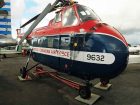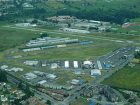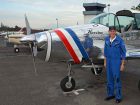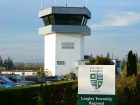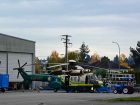
Features
Business Operations
Commercial
A Grand Vision
January 8, 2016 By Paul Dixon
Think globally and act locally would describe many businesses today, but you wouldn’t necessarily include a small regional airport on the outskirts of Vancouver on that list. Langley Regional Airport (CYNJ) is not as small as it might first appear and packs an economic punch far above its weight class.
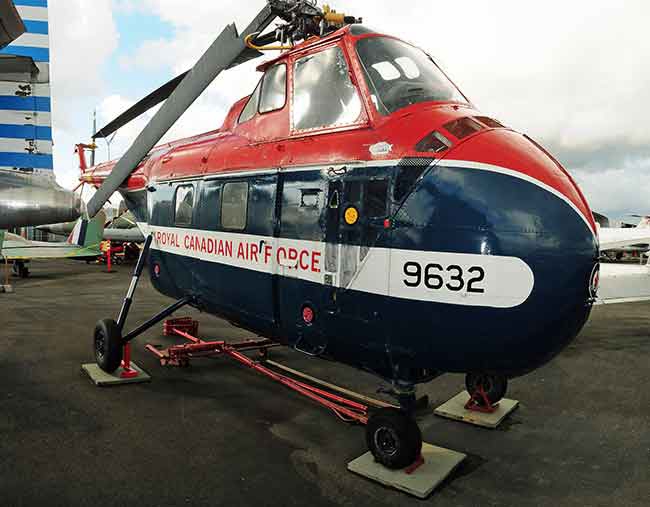 A Sikorsky S-55 (UH-19) at the Canadian Museum of Flight at Langley Regional Airport. Think globally and act locally would describe many businesses today
A Sikorsky S-55 (UH-19) at the Canadian Museum of Flight at Langley Regional Airport. Think globally and act locally would describe many businesses todayOriginally built in 1938 by the federal Department of Transport, the airport (or more accurately, airfield) had been planned as part of the Trans Canada Airway, a string of airfields from the prairies to the West Coast. The field served as a relief field for the larger Commonwealth training programs at Boundary Bay and Abbotsford. After the war, the Department of Transport continued to operate the airport before it was sold to the Township of Langley for $24,300 in 1967.
The airport was built on 120 acres, with the original 2,100 ft. north-south paved runway and a recently added 2,700 ft. east-west runway. When the airport was completed in 1938, the area was known as Langley Prairie, a rural farming community with a population that may have numbered in the hundreds. Today, Langley Prairie is just a geographical reference and the combined population of the City of Langley and Township of Langley is more than 140,000 and growing rapidly. The airport sits on its original site, but now multi-lane arterial roads border three sides, with a river running on the fourth. With no chance of growing horizontally, CYNJ is taking the vertical path by focusing on the rotary-wing market.
The Helicopter Philosophy
The decision to “go rotary” came in the early 1990s, when George Miller took over management of the airport after 35 years in the Royal Canadian Air Force (RCAF). Miller describes the circumstances that brought him to Langley as being “just by luck.” He learned of the job completion through a friend and came on board in 1991. The municipality wanted to hear how Miller would propose to build up the airport or turn it around, as there had been discussions about developing the site for other purposes. A plebiscite had been held in the City and Township and residents voted overwhelmingly to keep the airport, but with the stipulation that it needed to stay within that 120-acre footprint.
“My first job,” as he recalls, “was to take a look at the airport, get a feel and write a master plan for rebuilding the airport. My whole emphasis was on rotary-wing and general aviation, along with complementary commercial activity. There wasn’t any room to expand the runways, so we needed to build up our marketing plan for rotary-wing, because we only had a couple of companies at the time.”
So, in Miller’s words, he “got to it.” Tirelessly promoting the airport was job one, within the local community and across the broader aviation community. Part of that was becoming an active member of the BC Aviation Council (BCAC), where he served as president for five years. During his tenure with BCAC, he worked on creating a network-friendly environment.
“We got away from head tables and long tables and got into round tables of eight so people could have actual conversations and that became a really good way to introduce one’s self to helicopter people,” he says. Miller then started to build up a nucleus of companies by making the airport attractive to businesses. “I think we had the best lease prices in the Fraser Valley and the best fuel prices,” he says. “We got away from branded fuel and looked after it ourselves. [We implemented] long leases that allowed someone to build a business. Eventually, it started to fall into place.”
Taking the Reigns
The current airport manager, George’s son, Guy Miller, describes that attitude as a remarkable incentive. The airport has grown steadily over the years and is now a serious contributor to the local economy. The numbers from the economic development department at the Township of Langley show the airport generating $30 million in salaries, with a total output of goods and services of $158 million.
When Guy took over the airport operation, it was done through his own company, Avcon Consulting. In his words, Guy Miller joined the RCAF right out of university, flew the F-18 Hornet for seven or eight years, and then went off to fly the B747 for Cathay Pacific. “Once I’d been in Hong Kong for a decade or so, George gave me a call and asked me if I wanted to come back and help him at Langley,” Guy said. That was 10 years ago. He worked for Avcon for seven years and then three years ago, the Township of Langley took over operation of the airport. Today, Guy Miller is a municipal employee as the airport manager, reporting directly to the township CAO.
“It’s been beneficial,” Guy says. “While there were benefits as a contractor, we get a tremendous amount of support from the township with the engineering department, accounting, payroll, finance – before that was all contracted out. If we need a snowplow, we pick up the phone and call engineering. That’s a lot different than it used to be.”
Vector’s New Home
Guy Miller has continued what George started. Ten years ago, the north side of the airport was simply an open field. In the spirit of community involvement, the airport would host Canada Day celebrations that would draw huge crowds of up to 60,000 over a weekend. Today, the fields are disappearing under a wave of new construction that will see more than 200,000 square feet of buildings erected.
Vector Aerospace is constructing an 88,000 square foot new facility on the north side, which will incorporate new avionics and structures shops, with 65,000 square feet of hangar space under one roof. The new building is designed to bring the current Langley workforce, currently working in a number of different buildings, under one roof. When the facility is up and running, it is expected to add a further 180 jobs and, in turn, attract major investments and nearly double the technical activity and production of the airport.
As Vector moves over from its current facilities, other businesses are lining up to move in. CanWest Aerospace is located next door to Vector’s current location on the south side and is planning to add 10,000 square feet to its current building. What drives companies in this region isn’t the local or regional helicopter business as much as the global market.
CanWest’s Tom Roberson says 90 per cent of his company’s business is from outside Canada. “What has made us successful is diversifying into the overseas markets. We haven’t been seeing the slowdown in our business that others have seen from the downturn in oil and gas. We were just awarded a $35 million contract by the Egyptian government. We will maintain, support and upgrade their Sea King and S-61s for the next five years. The U.S. State Department is one of our biggest customers as well. They still fly plenty of S-61s. That’s our focus and we’re trying to expand more on the corporate side, interiors and paint. People will come half-way around the world to get it done here because it gets done right.”
Just the Right Spot
Down the road from CanWest, TRK Helicopters is now located in its new 6,000 square foot hangar and office complex, having moved over from a smaller building. TFK does the bulk of its flying in northern B.C. and the Yukon, so why does owner Randy Marks choose to have his offices and maintenance facility in Langley? It’s quite simple: he doesn’t want to live anywhere else and it’s still more efficient for TRK to do its maintenance work here. It offers ease of access and relatively affordable (by Vancouver standards) real estate in the local communities that make Langley airport an attractive sell for companies looking to recruit personnel. It’s far enough out of the big city to be affordable, but close enough to take advantage of what the city has to offer.
Lyle Watts has operated Heli College Canada Training for 22 years. For him, Langley is an ideal location for a training school, offering a great diversity of landscape in every direction. “It’s close to Abbotsford for IFR, it’s close to the mountains, Pitt Lake and Mud Bay,” he says. As surprising as it is to realize how much business local companies do outside Canada, it is equally surprising to realize how many students come to Heli College from around the world. And there’s a good reason: the high level of expertise offered by the school.
“People like Geoff Stevens, who is the highest time Robinson pilot in the world, with more 19,000 hours,” Watts explains. “I’ve got 42 years in the business, I’m an instrument and VFR examiner. It seems strange to some that you will find these qualifications in a small place like Langley.” Of course, word of mouth also plays a role. If one student from Europe phones friends back home, they came over. The halls of Heli College’s office are lined with hundreds of Polaroids of graduates, including more than a hundred CHC pilots who trained here over the years.
More Movement
RCMP Air Services moved its helicopters from YVR to Langley in July 2013. Langley is located almost at the geographical area that Air 1 and Air 2 are responsible for. The move ensures more timely responses to many areas of metro Vancouver and removes the potential of conflict between commercial airliners and police helicopters at a major airport. There is also a significant saving realized as the shorter response distances mean less fuel burn, coupled with lower hangar rental.
The Canadian Museum of Flight has outgrown its facilities on the south side of the airport and is awaiting final rezoning approval to move to a new site on the southwest corner of the airport. When the museum moves to its new building, the airport is already planning for upgrades to the area being vacated. Carol Madill, airport operations assistant, sees it as a chance to upgrade, put services underground and get things modernized. “It’s snowballed like crazy and now it’s starting to fill in and we’re constantly having people here finding other places to move to – and now we will have more movement with the (old) Vector space opening up. People want to be here because we’ve got the big hitters here.”
The Journey Ahead
Yes, the seeds that were planted by George Miller are certainly germinating, as the airport continues to thrive. From just a handful of businesses 25 years ago, there are now 55 on the airport grounds, with most of them connected to the rotary-wing world. There continues to be strong support for the airport from the community. With the penchant for further growth and global opportunity, Langley Regional Airport is poised to have a very strong and bright future.
Laying the Foundation – George Miller’s Vision Paved the Path for Success
On his 80th birthday, George Miller did what he’s been doing most of his life – he went flying. Miller spent the afternoon leading the Fraser Blues, the display team he founded in 2001, through its paces in the skies over Langley, B.C. and the Fraser Valley.
It’s a long way in time and distance from that day in 1953 when the recent high school grad walked into the RCAF recruiting office in Ottawa, but most 18-year-olds today would be hard-pressed to keep up with him.
Accepted by the RCAF, he soon found himself in an airplane for the first time in his life. He was learning to fly the Harvard Mk 1, not the friendliest of machines for a novice. At the age of 19, he was flying Sabres in Europe.
By 1962, he had discovered an aptitude for aerobatic flying and was chosen as the lead soloist for the Golden Hawks, performing at 70 air shows across North America that year, before returning to Europe and transitioning to the F104 Starfighter.
In 1972, Major Miller was chosen as the second team leader of the RCAF’s Snowbirds. Under his leadership, the team became the nine-aircraft demonstration team, still unique in the world of aerobatic flying.
He introduced new uniforms for team members and ground crew and was also responsible for the team adopting CFB Comox as their pre-season training home, a tradition that endures to this day.
Miller served 35 years in the RCAF and after a short tour in the commercial aerospace market and private business, he signed on with CYNJ, where he stayed until January 2015.
In 2001, Miller formed the Fraser Blues formation display team. Headquartered at Langley Regional Airport, the team flies North American Navion aircraft. Over the past 15 years, the team has appeared at scores of air shows and community events across Western Canada and neighbouring states.
During his career, Miller has received numerous awards and citations. In June 2007, the BC Aviation Council presented him with its Lifetime Achievement Award. In June 2015, he was inducted into the Canadian Aviation Hall of Fame, but the biggest reward of all just might be that after 61 years he’s still doing what he loves.
